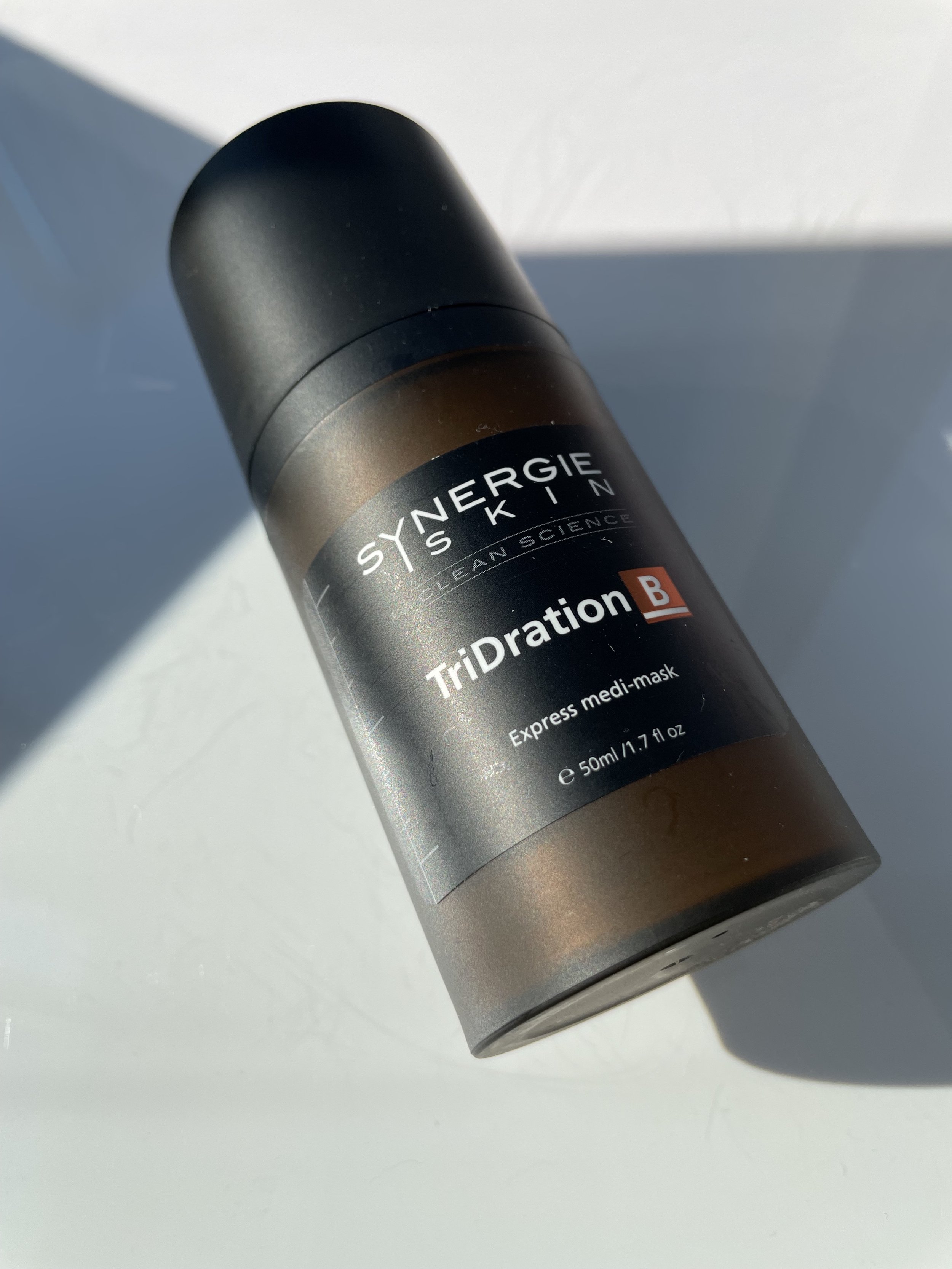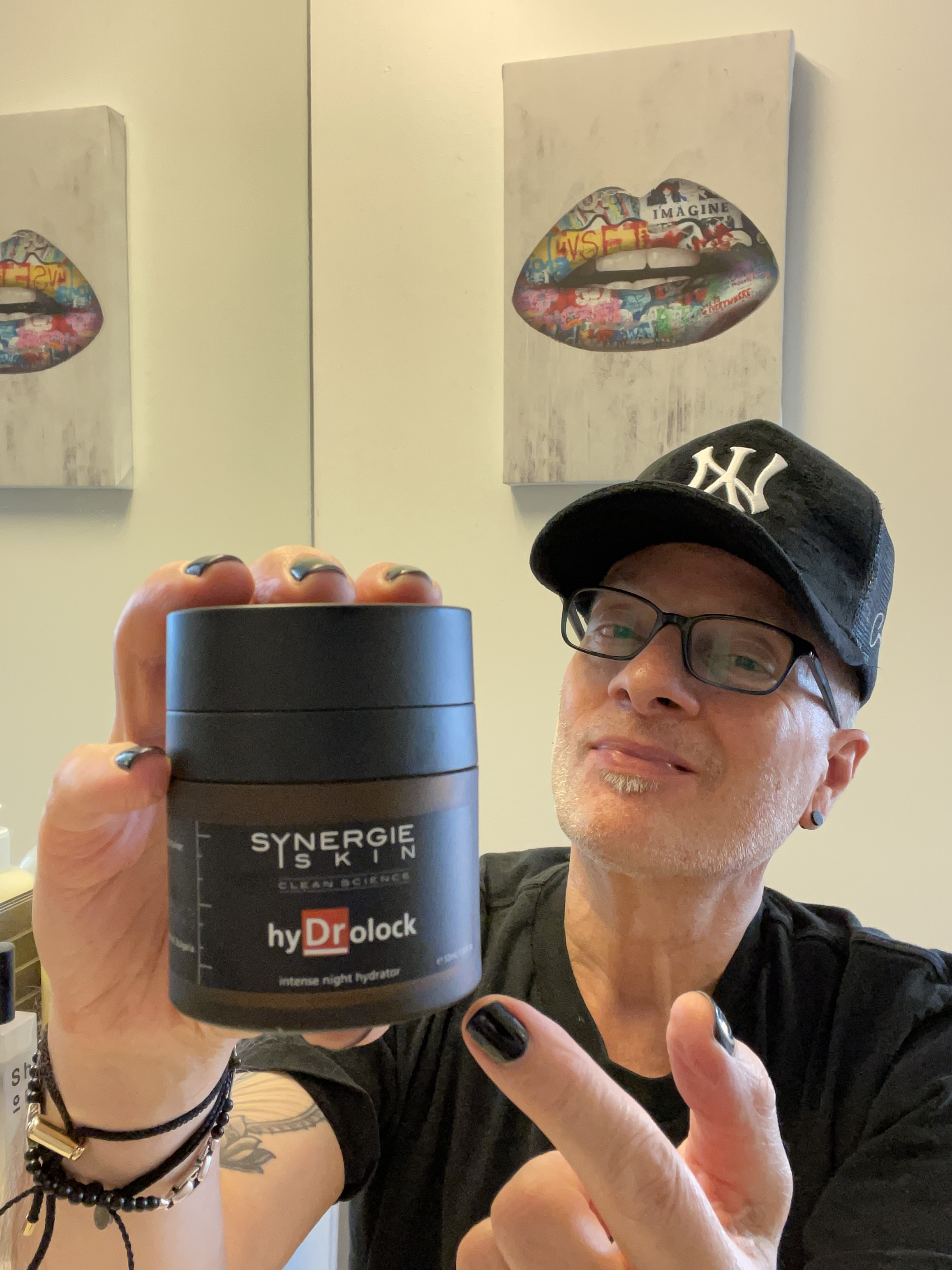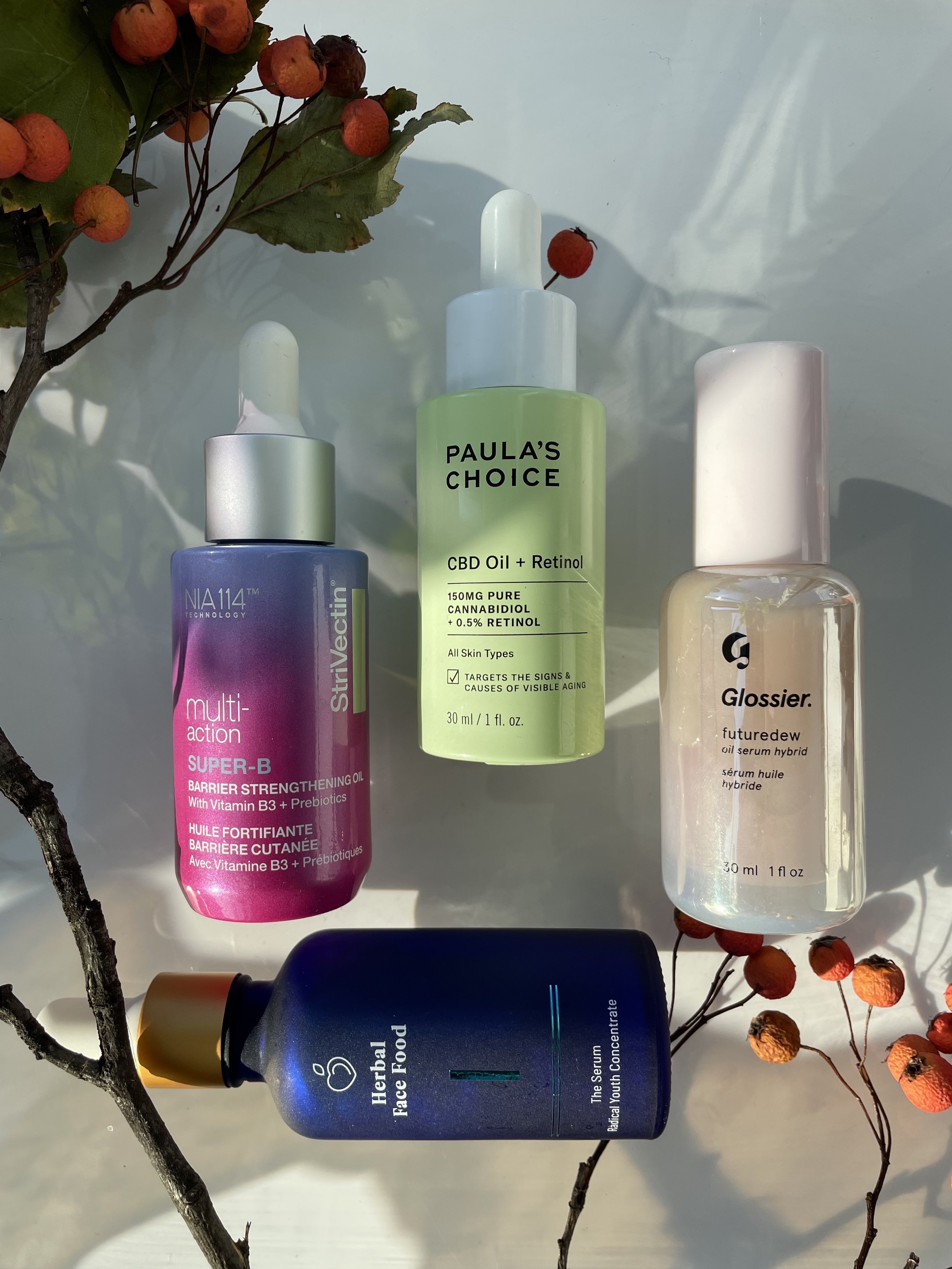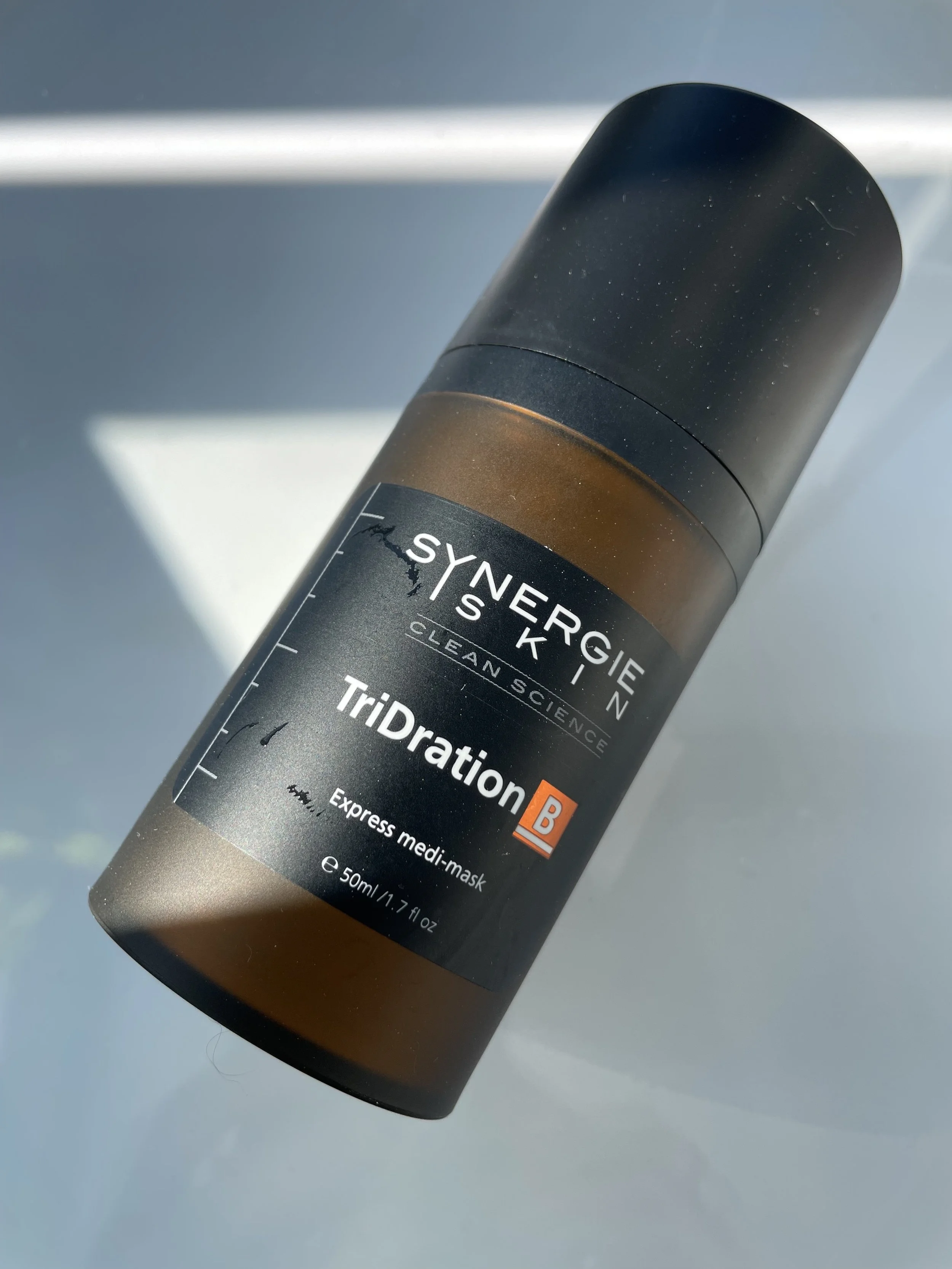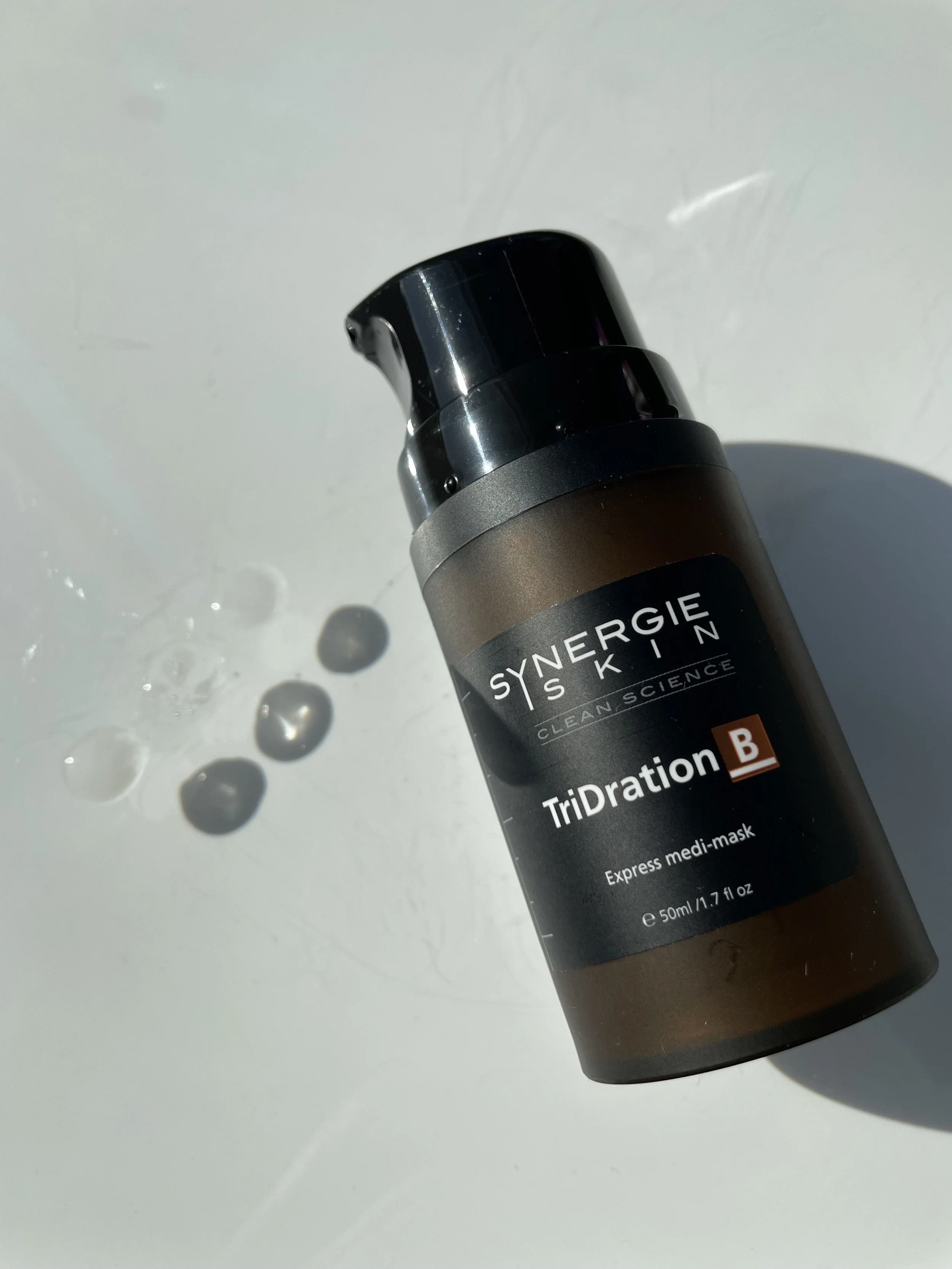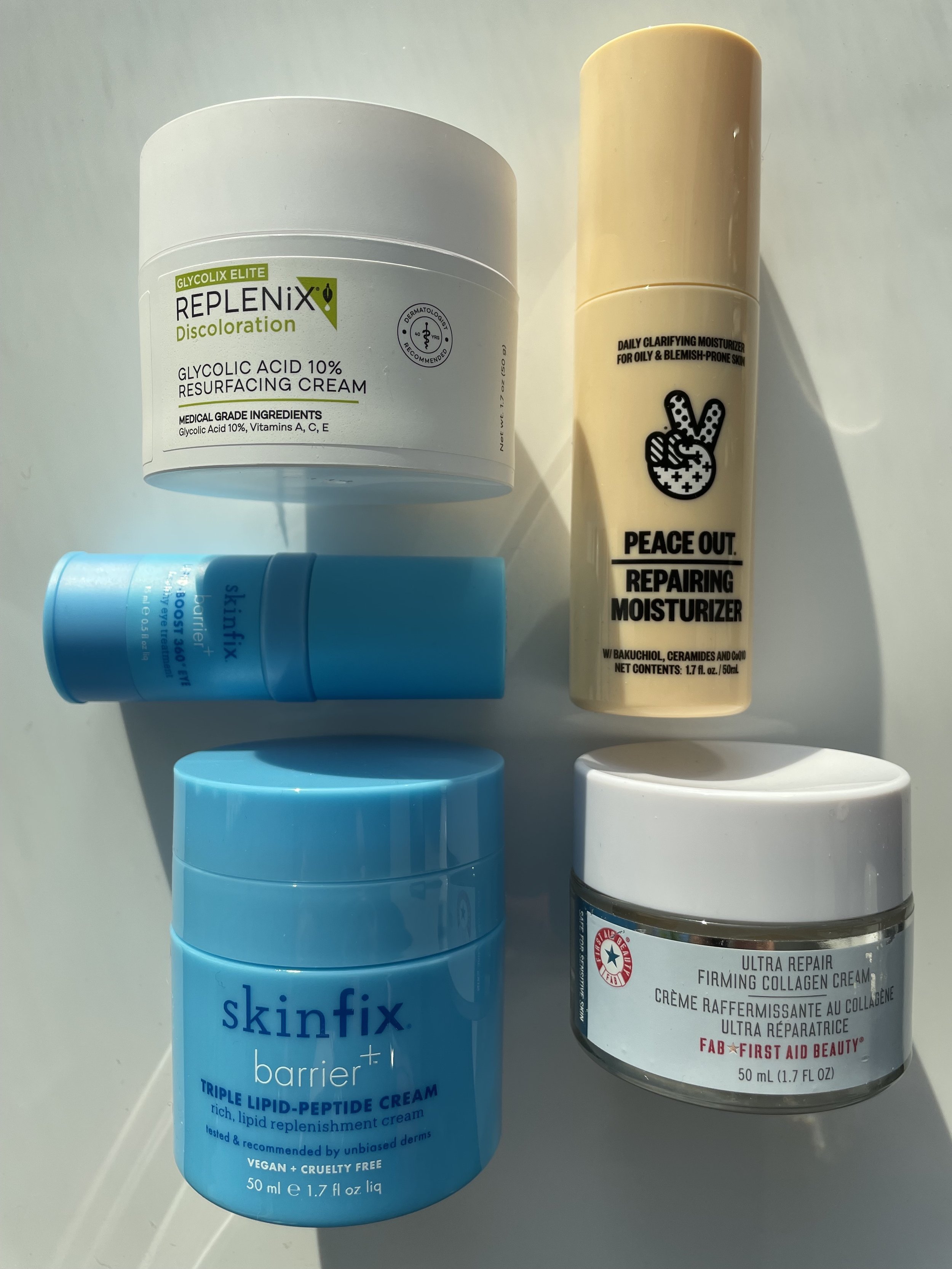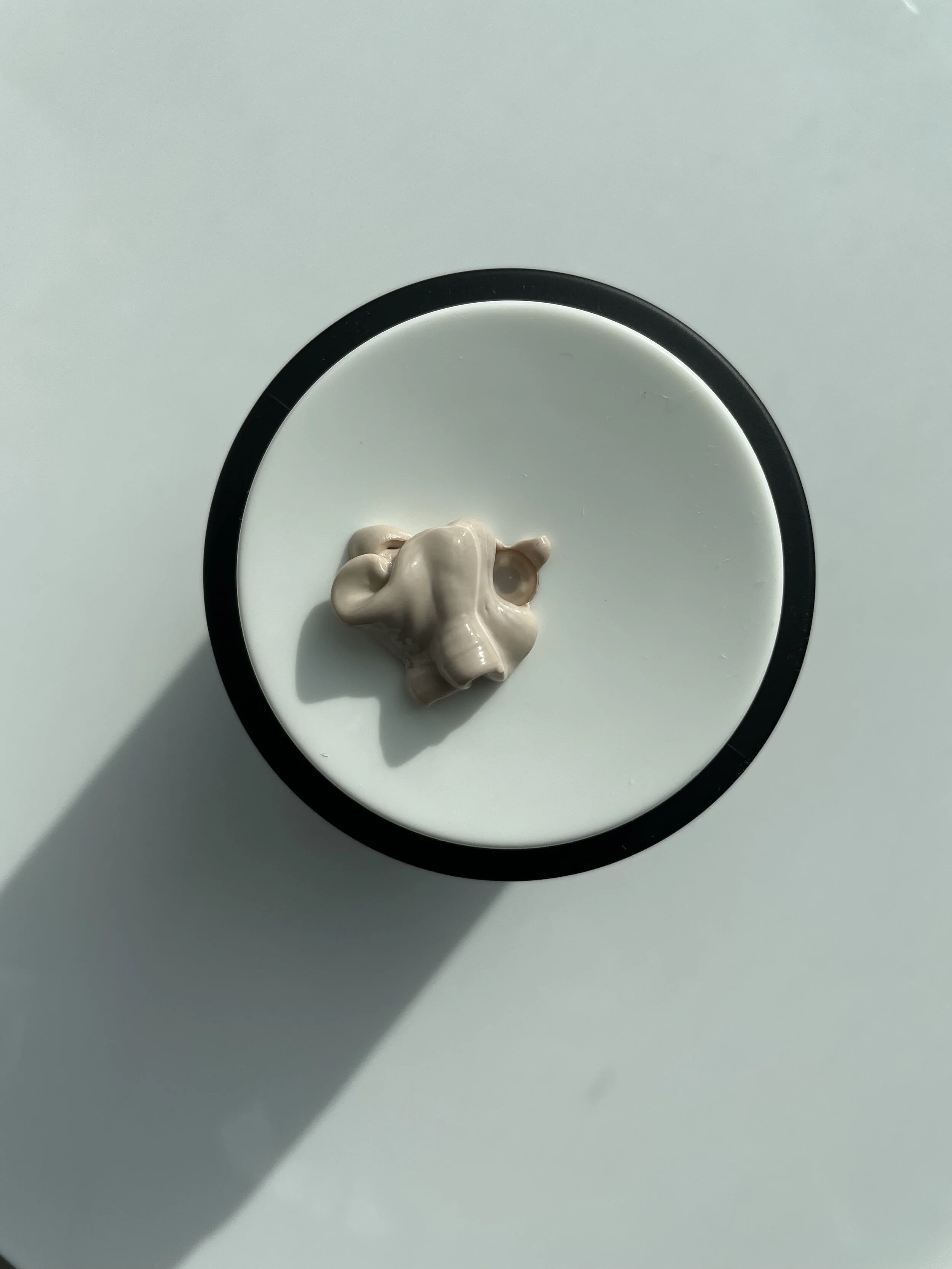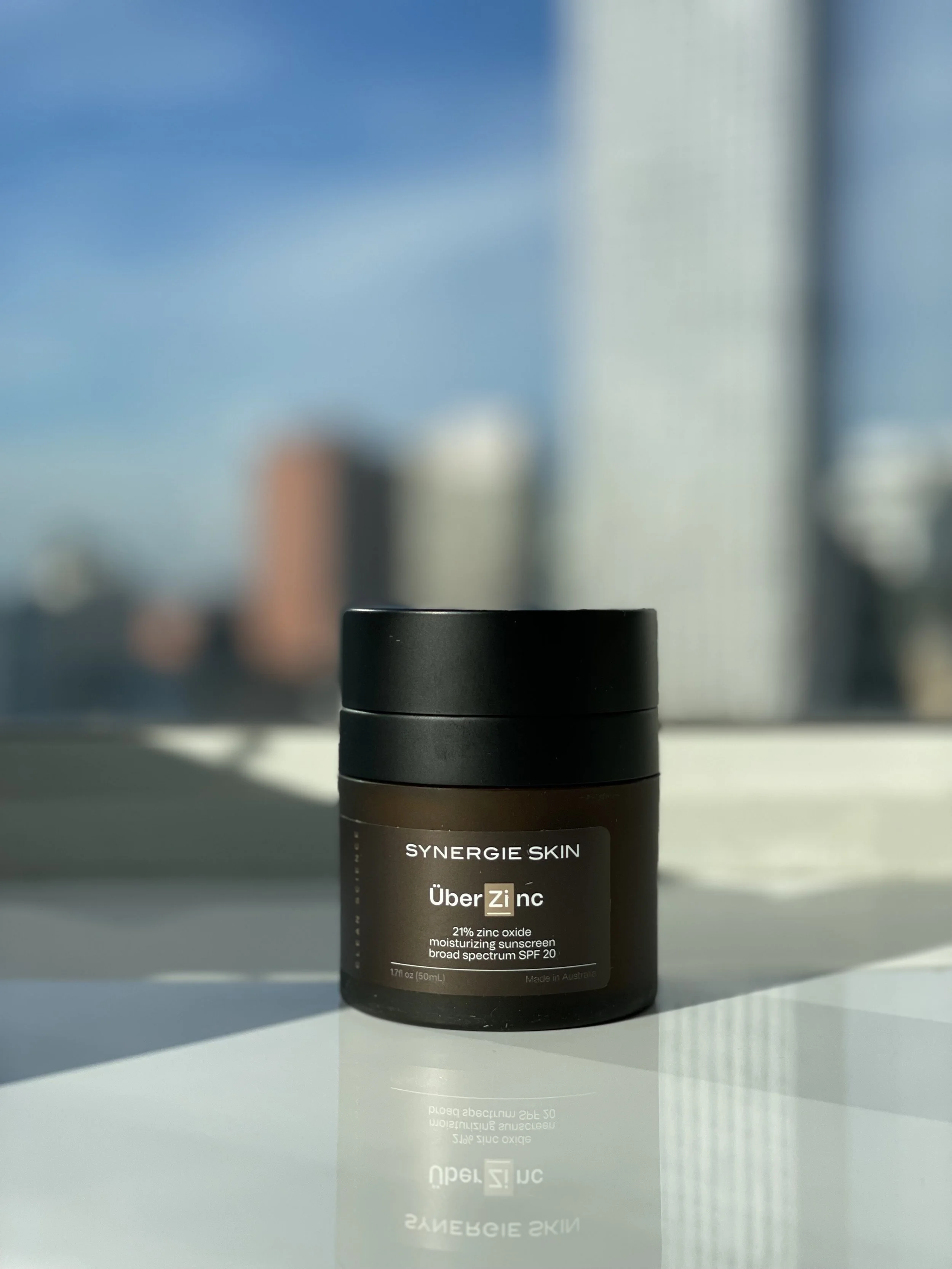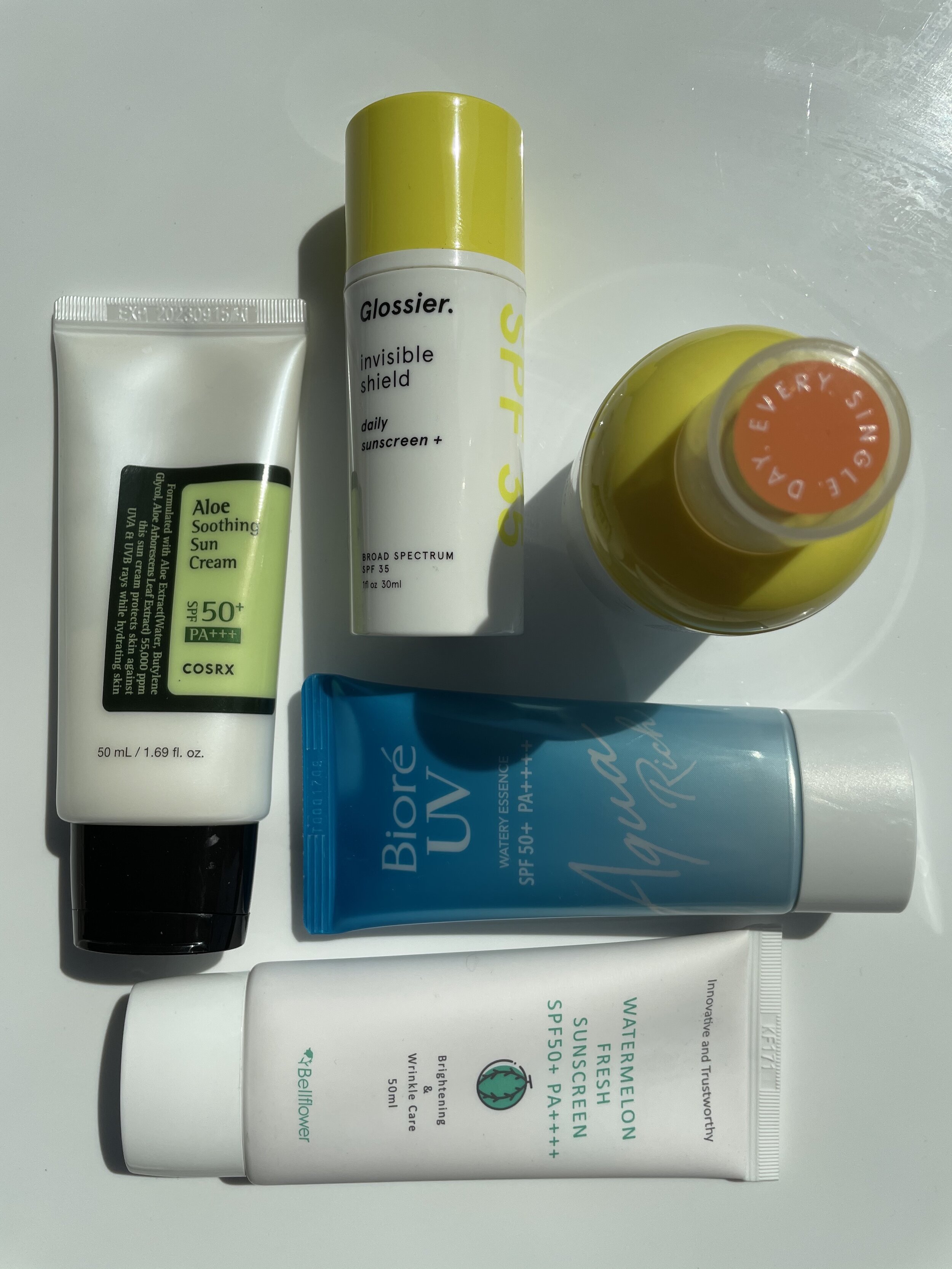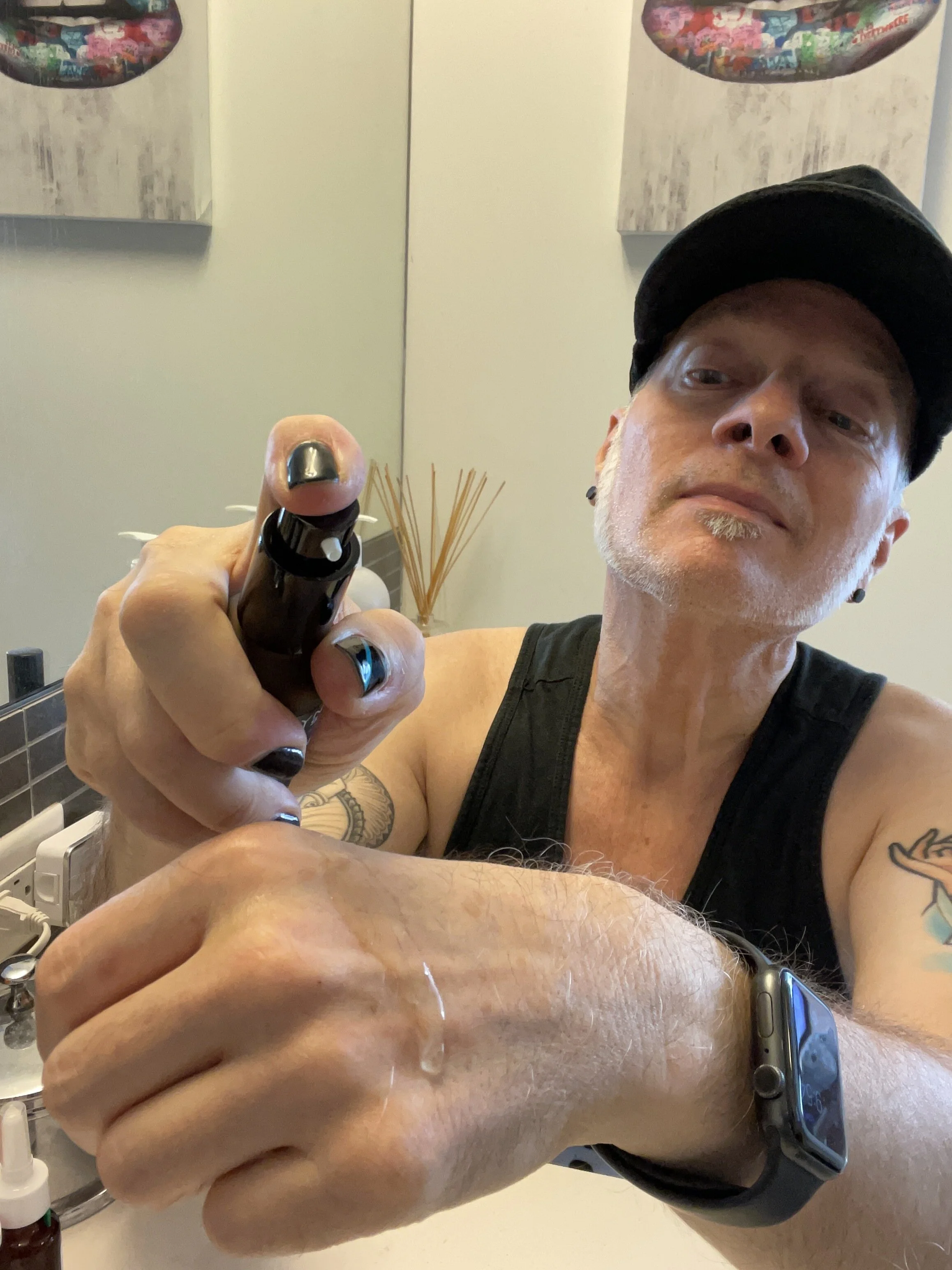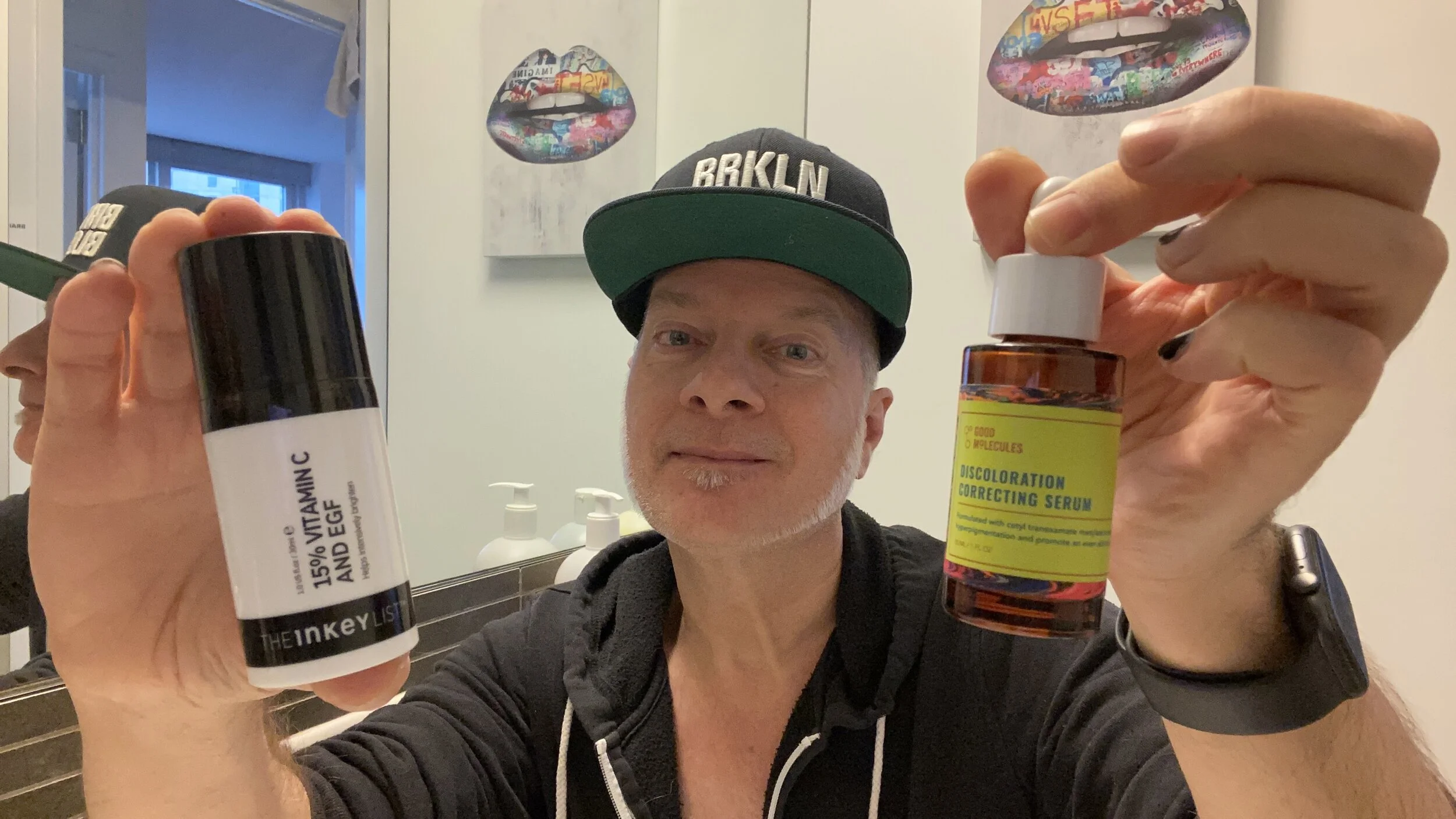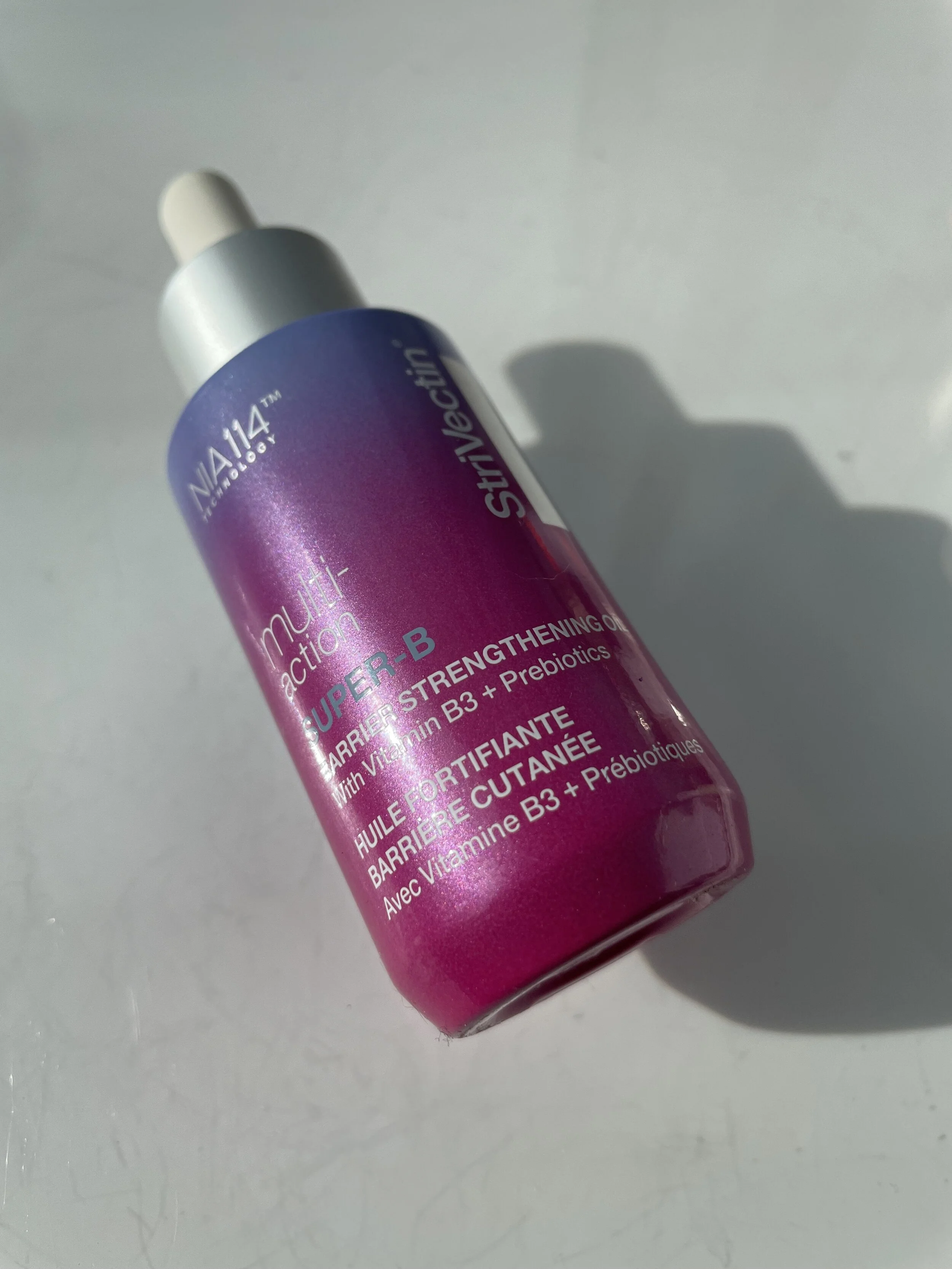SEASONAL SKINCARE TRANSITIONING: SYNERGIE SKIN TRIDRATION B - BEST BRIGHTENING MASK, BEST HYDRATING MASK
My favorite skincare discoveries are more often than not from brands that harness the latest scientific advances and ingredient insights.
That generally means clean, clinical, and high-performance skincare with high concentrations of pro-skin health actives like antioxidant vitamins, water-binding humectants and, of course anti-aging sunscreens.
It’s indisputable, sunscreen is the most anti-aging of all skincare products!
With clean, clinical-strength formulas, one of my latest brand discoveries of 2021 is Synergie Skin. Their antioxidant serums, mineral sunscreen and rich moisturizers are exceptional.
I first shared about the cool, nerdy science brand from Australia a few weeks ago when I featured Synergie Skin’s Vitamin B 13% Essential Niacinamide Serum in my most recent article on new Niacinamide serums titled, Niacinamide Serums To Get Your Complexion Going And Glowing Ss21 From Naturium, Synergie Skin & More.
You can still catch the full article here.
NIACINAMIDE SERUMS TO GET YOUR COMPLEXION GOING AND GLOWING SS21 FROM NATURIUM, SYNERGIE SKIN & MORE
The piece included my favorite new Niacinamide serums, one of which continues to be a staple in my daily “pore maintenance” routine. (Psst…it’s the Synergie Skin Vitamin B 13% Essential Niacinamide Serum!)
I literally never skip a Niacinamide serum in either my AM or PM routines. Even if I’m tired AF at night, I’ll always wash my face and apply Niacinamide. With a 13% concentration of the versatile antioxidant, Synergie Skin’s Vitamin B 13% Essential Niacinamide Serum is one of the best Niacinamide serums for brightening the skin and protecting against skin-aging environmental damage.
Meet Synergie Skin!
With really well-formulated, cruelty-free skincare that’s highly pro-skin health, Synergie Skin nails it. Founded in 2005 by biological scientist and cosmetic chemist Terri Vinson, Synergie Skin formulates its uniquely intriguing skincare by harnessing the synergy of science and nature.
From the brand:
Terri is both managing director and cosmetic chemist, possessing a rich understanding of science with a passion to educate. Her academic background in biological science enables her to formulate with a holistic understanding of all ingredients, their functions, and their efficacy on the skin. From the initial concept to the final product, she oversees the evolution of every product she creates.
Terri is always at the forefront of the cosmetic industry and seeks to formulate only with the latest in active, ethical, and safe ingredients, according to her Clean Science philosophy. Key ingredients in our formulations are verified by clinical data and supported by sound science, not the latest fad.
Synergie Skin’s range of nerdy, high-potency products come in recyclable brown glass pharmaceutical bottles that remind me a lot of my all-time favorite high-science brand, Deciem’s NIOD.
Synergie Skin’s products have really intriguing names like XCell B, TriDration B and ÜberZinc — one of the uber-coolest mineral sunscreens I’ve discovered over the past year.
I’m particularly impressed with the brand’s commitment to sustainability and ethical manufacturing, something that’s clearly delineated on the brand’s website: “Synergie Skin is dedicated to creating an environmentally positive manufacturing facility. We are committed to a sustainable waste management system and manufacturing processes and are proud to pledge that our Australian facility will be run entirely by solar energy by 2022.”
While I love just about everything I’ve experienced from Synergie Skin, a few of the brand’s products stand out for me. One of the most intriguing is the Synergie Skin Dermiotic Pre-Serum Elixir — a superbly pro-skin health, microbiome balancing elixir that should be part of every skincare regimen.
FOR A LIMITED TIME
ENJOY 10% OFF ALL SYNERGIE SKIN SKINCARE!
CLICK HERE AND ENTER CODE SKINCARMA AT CHECKOUT
The Synergie Skin ÜberZinc has become a new personal favorite. How do I know when I love a sunscreen? Because I get excited to apply it! (Psst…if you love it, you’ll wear it!) And, of course, Synergie Skin’s Vitamin B 13% Essential Niacinamide Serum really made a splash in my latest deep dive into Niacinamide serums.
And the brand’s HyDrolock Intense Night Hydrator is one of those exceptionally rich moisturizers that doubles as a sleeping mask, the type of product I want in my arsenal during the dry, colder months when the life seems to be sucked out of my face while I sleep.
With that, let’s take a look at the Synergie Skin products that have impressed me most — including my newest discovery from the brand, Synergie Skin’s TriDration B Express Medi-Mask...
Synergie Skin | TriDration B Express Medi-Mask
For sure, Synergie Skin is one of my favorite brand discoveries of 2021. Every product I try from the clean science brand impresses me. And my latest discovery is their TriDration B Express Medi-Mask.
The TriDration B Express Medi-Mask is a super cool “medi-mask,” a gel mask ideal for keeping skin healthy and hydrated in dry, cold air. In fact, with its blend of powerful humectants and hydrators, the TriDration B does an effective job of locking water into the skin — in what I refer to as the Skincarma “Lock and Block” strategy. Humectants like Hyaluronic Acid, Glycerin and Aloe lock moisture in the skin to prevent trans-epidermal water loss and subsequent dehydration.
During the drier, low-humidity months of fall and winter, it is essential to transition your skincare to focus on hydration — or preventing dehydration. The dry air around us works like a magnet to draw water out of the skin faster than the skin can replenish it. Humectant complexes like those found in the Synergie Skin TriDration B Express Medi-Mask are the best way to help the skin hold as much water as possible.
Over the last several weeks, I’ve explored dehydration and what I term “seasonal skincare transitioning” in a series of articles on the blog. My most recent piece was titled, Seasonal Skincare Transitioning: Facial Oils I Love that Make Me Excited for Cold Weather - Part Two. You can catch it here.
SEASONAL SKINCARE TRANSITIONING: FACIAL OILS I LOVE THAT MAKE ME EXCITED FOR COLD WEATHER - PART TWO
The Skincarma “Lock and Block” Prevents Dehydration
To start, preventing dehydration in the first place requires drinking enough water. That differs for each of us based on our weight, the foods we eat, and the climate we live in. It’s even more important during colder periods.
A good rule is to drink one ounce of water each day for every pound of body weight. So, if you weigh 150 lbs., you’ll need to drink 150 ounces of water each and every day to keep your body and your skin optimally hydrated.
Then, employing skincare to treat and prevent dehydration requires what I refer to as a “lock and block” strategy.
It begins with a dedicated humectant serum applied to the skin in both your AM and PM routines that helps to lock water in. Follow with a moisturizer composed of a healthy balance of both humectants and oils to block and prevent the trans-epidermal water loss that can lead to dehydration.
Synergie Skin’s TriDration B is a high-potency “medi-mask,” with advanced benefits to get the job done in just 5 minutes. How? It’s infused with what the brand refers to as a cocktail of “water magnets, water balancers and hyaluronic acid stimulating ingredients” that deeply hydrate skin to prevent trans-epidermal water loss, or TEWL.
TEWL is the main culprit in skin dehydration and preventing it should be the focus of any serious, pro-skin health routine during the colder months.
What Is Trans-Epidermal Water Loss?
For a deep-dive into trans-epidermal water loss (or TEWL), there’s an excellent article on the health website Skin Better titled, What Is Transepidermal Water Loss and Why Is it Important? It’s available to read here. In the piece, the author explains TEWL as follows:
“The skin is comprised of three primary layers: the epidermis, the outermost layer; the dermis or middle layer; and the hypodermis, the undermost layer. When water passes from the dermis through the epidermis and evaporates from the skin’s surface, this is known as transepidermal water loss (International Journal of Pharmaceutics).
While TEWL is a process that your skin naturally regulates, certain factors that can damage the skin’s barrier function can also affect TEWL levels. Circumstances such as injury, low-humidity weather conditions and topically applied products that dry out the skin can impact TEWL.
To achieve this, combine humectant and occlusive skincare ingredients.
Transepidermal water loss can contribute to a variety of dry skin conditions, and although it is a natural process, there are ways that you can help your skin stay moisturized and hydrated. Hydration refers to the water content of the skin, whereas moisturization is the skin’s ability to retain those water molecules. Therefore, your skin needs both elements to maintain desirable levels of TEWL.
To achieve this, combine humectant and occlusive skincare ingredients. Humectants help to draw moisture to the epidermis, either from the air if it is humid enough, or from the underlying dermis in low-humidity conditions. Because water content that is drawn from the dermis can be lost through TEWL, it’s important to combine the use of humectants with occlusives. Together, these ingredients create a reservoir of moisture in the epidermis and act as a barrier on the skin to help prevent TEWL by sealing in that moisture. The occlusive agents simultaneously keep pollutants, toxins and harmful bacteria out (Skin Therapy Letter).”
But TriDration B is much more than one of the best hydrating masks for preventing dehydration. It’s got serious brightening oomph that’s powered by Hydrolyzed Tomato Skin — a potent antioxidant that can brighten the complexion, boost antioxidant defenses, and offer redness-reducing benefits. There’s also an 11% concentration of Niacinamide that helps to strengthen the skin barrier over time, in addition to delivery visible brightening and helping to defend the skin from skin-aging environmental aggressors.
I love this mask’s lightweight gel-like consistency. It almost feels like a gel-oil, if that makes any sense. And hey, it’s perfect in the cold!
What I like about it: The Synergie Skin TriDration B Express Medi-Mask is ideal for seasonal skincare transitioning when the focus becomes preventing dehydration in dry, low-humidity air. I love using it on an early weekend morning when I’m not going outside until later — if at all.
What I don’t like about it: I actually like everything about it.
Who it’s for: All skin types, especially very dry and sensitive.
SHOP THE BLOG: For a limited time, save 10% off all Synergie Skin skincare. Purchase the Synergie Skin TriDration B Express Medi-Mask for $71.10 (reg. $79) here.
FOR A LIMITED TIME
ENJOY 10% OFF ALL SYNERGIE SKIN SKINCARE!
CLICK HERE AND ENTER CODE SKINCARMA AT CHECKOUT
Synergie Skin | HyDrolock Intense Night Hydrator
Over the last two months, I’ve made it my mission to find the perfect face creams for colder weather. I kicked off what I call “seasonal skincare transitioning” in mid-October with my annual series on ideal moisturizers for the colder weather.
My two-part series titled, Seasonal Skincare Transitioning: Moisturizers I Love That Make Me Excited For Cold Weather features collections of the best face creams for dry, dehydrated skin. This year, I selected four distinct moisturizers in each article and designated the unique skin type that I believe they’re best for — in each of the main categories: DRY SKIN, OILY / BLEMISH PRONE SKIN, SENSITIVE SKIN and ALL SKIN TYPES.
SEASONAL SKINCARE TRANSITIONING: MOISTURIZERS I LOVE THAT MAKE ME EXCITED FOR COLD WEATHER
During fall and winter, my skin always feels like it’s under an invisible, insidious attack from the forces of cold air. If I don’t take extra care by switching up my routine, like many people this time of year the consequences of dry, dehydrated skin can be pretty extreme. Contrary to what skincare marketers will tell you, dehydration or lack of water in the skin, is one of the key causes of skin aging along with sun damage. Skincare brands just don’t talk about that enough.
To promote optimal skin health, I think it’s super important to educate on the differences between dry skin and dehydrated skin at every chance I get…
What’s the Difference between Dry Skin and Dehydrated Skin?
Many people confuse the two. They’re not the same thing. Dry skin is a skin type — like oily skin and sensitive skin. Dehydrated skin, on the other hand, is a skin condition – just as being thirsty is a sign that your body is dehydrated. Dehydrated skin lacks water and any skin type, no matter its level of dryness or oiliness can be dehydrated.
In particular, dehydration is something that’s common to all of us in the cold as the low-humidity air around us draws water through the skin barrier and out of our skin. This process is referred to as trans-epidermal water loss, or TEWL.
As the cold weather kicks in, I think it’s helpful to understand the difference between dry skin and dehydrated skin in order to protect your skin health in the weeks ahead. For insights, I turned to the experts on the Paula’s Choice Research Team. There’s a superb piece on the Paula’s Choice site titled, What is Dehydrated Skin & How to Choose the Best Products.
Here is an excerpt:
Dehydrated skin often looks and feels like dry skin all over your face, but there's a major difference between the two: dehydrated skin is usually a temporary concern (with various surprising causes) and dry skin typically doesn't change over time. If you have dehydrated skin, your skin may also produce a normal or even excessive amount of oil on its surface.
"Dehydrated skin" is something we’re asked about frequently. It seems there’s a lot of confusion about what this skin concern is about. A major part of the confusion is that the term "dehydrated skin" is often used interchangeably with "dry skin" or "combination skin" but they are not the same! Dehydrated skin can occur in all skin types and is not exclusive to those with dry skin or combination skin.
The Difference Between Dry Skin and Dehydrated Skin
Having classically dry skin is easy to recognize. Dry skin frequently feels tight and dry, with no oil anywhere to be seen. This situation rarely fluctuates; skin feels dry all year long. The dryness might get worse depending on the climate, season, or activity, but regardless of those things, without great skin care products, the uncomfortable dry, tight feeling will persist.
As mentioned above, dehydrated skin can look and feel similar, but there’s a major difference: Dehydrated skin tends to come and go, it does not persist.
So, during the colder months it’s essential to infuse skin with oil-based moisture and water-based hydration during your AM and PM skincare routines. Just washing your face and applying a moisturizer isn’t enough. If you have skin, no matter your skin type, it needs both oil and water.
I’m excited to share that Synergie Skin’s HyDrolock Intense Night Hydrator does both. It’s ideal for preventing dryness and dehydration in the cold.
What does HyDrolock do?
To start, I have to say I love the name. I’ve named hundreds of skincare and hair care products over the years and would be proud to say I’d come up with “Hydrolock”! As catchy as the name is, it indicates exactly what the product does: locks moisture and hydration in the skin.
To infuse skin with oil-based moisture, the dense HyDrolock cream is rich in non-fragrant plant oils like Sweet Almond Oil, Shea Butter and Castor Seed Oil — all of which are in the top 10, always an indication to me that they’re at high concentrations and likely to truly benefit the skin.
That’s not to say that if an ingredient isn’t at a high concentration it isn’t effective. Many ingredients do not need to be among the dominant actives in a formula to perform. In the case of plant oils, the more the better.
To keep skin hydrated, there are multiple humectants at high concentrations, also important to the formula’s efficacy as a hydrator.
Among the most most notable humectants in Synergie Skin’s HyDroloc formula are honey, Aloe Vera Leaf Juice, Lanolin and Beta-Glucan — a humectant that’s more effective at locking water in the skin than the superstar Hyaluronic Acid.
What is Beta-Glucan? According to the experts on the Paula’s Choice Research Team,
Beta-glucan is a polysaccharide (complex sugar) that can be derived from various natural sources such as yeast, fungi, seaweed, or oats. It is commonly included in skin care products as a soothing agent and is considered an excellent ingredient for minimizing redness and other signs of sensitive skin.
Beta-glucan also offers antioxidant properties and has been shown to help visibly minimize signs of aging/sun damage (including reducing the look of wrinkle depth and rough, uneven tone). Certain sources of beta-glucan also offer film-forming moisturizing properties.
In early research, it was hypothesized that beta-glucan’s high molecular weight would inhibit it from penetrating skin, thereby limiting its benefits to just the surface, but in more recent studies, beta-glucan has been proven to permeate skin by passing between cells.
HyDrolock has a thick, gooey texture that makes it ideal for dry cold nights. You know winter is here when you wake up looking haggard. It’s dipped into the 30s at night in New York City, and with HyDrolock, I wake up fresh and healthy looking, hardly haggard!
I’ve begun applying it to my neck in my AM routine to combat moisture loss during the day. Once it gets super cold outside, I’ll want to use HyDrolock as a daily moisturizer over the rest of my face, too.
What I like about it: The Synergie Skin HyDrolock Intense Night Hydrator is one of the richest and most effective sleeping mask treatments I’ve tried. I love the morning-after effects.
What I don’t like about it: HyDrolock has a subtle floral botanical scent to it that may be off-putting to some. For me, it dissipates quickly enough.
Who it’s for: Dry skin types year-round and all skin types except very oily in the dry, colder months.
SHOP THE BLOG: For a limited time, save 10% off all Synergie Skin skincare. Purchase the Synergie Skin HyDrolock Intense Night Hydrator for $91.80 (reg. $102) here.
FOR A LIMITED TIME
ENJOY 10% OFF ALL SYNERGIE SKIN SKINCARE!
CLICK HERE AND ENTER CODE SKINCARMA AT CHECKOUT
WATCH MY VIDEO REVIEW
KEEPING MY SKIN HYDRATED WITH SYNERGIE SKIN’S HYDROLOCK!
ON MY YOUTUBE CHANNEL HERE
Synergie Skin | Dermiotic Pre-Serum Elixir with Prebiotic and Probiotic Complex
I think many skincare users, whether novices or serious skincare junkies, can get caught up in the idea that you need to see immediate visible results in order to know if a skincare product is actually working for your skin.
There’s a lot of danger inherent in that premise. Very often, the signs that something is “working” are really signs that skin is being irritated, not that it’s being treated to something that’s promoting skin health. A tingling, warming or cooling sensation is common with high levels of fragrance or fragrant plant oils like peppermint, orange or lavender oils. Fragrance isn’t skincare!
With direct acids like Glycolic Acid at high concentrations, sure a tingling sensation is expected. Hey, if you don’t experience intense tingling when using the Paula’s Choice 25% AHA + 2% BHA Exfoliant Peel, you’re dead inside. It’s one of the most potent exfoliating treatments I’ve come across and the best Glycolic Acid serum for immediately igniting the complexion.
PRODUCT REVIEW: PAULA’S CHOICE 25% AHA + 2% BHA EXFOLIANT PEEL – BEST AHA EXFOLIATING TREATMENT
And while acids like Glycolic Acid, Lactic Acid and others certainly deliver instant results, ingredients like antioxidants, probiotics, peptides and even sunscreen filters don’t. Their effects on the skin are long-term. You see little, if any, immediate benefits. That’s what a healthy skincare routine is all about — slow and steady. As they say, “slow and steady wins the race!”
Probiotics are among the most intriguing of the latest class of supremely pro-skin health actives.
What Are Prebiotics and Are Prebiotics Good for Skin?
Prebiotics, probiotics and post-biotics are a legitimate trend in skincare over the past two to three years — with probiotics, or good bacteria, leading the way. So what exactly are “prebiotics” and what is their benefit to the skin?
According to the experts on the Paula’s Choice Research Team, prebiotic are becoming increasingly important in the maintenance of skin health. The team outlines its unique benefits to the skin and body in an article titled simply, What Are Prebiotics for Skin?
An excerpt from the piece:
Prebiotics are an intriguing group of ingredients making skin care headlines because of the important role they can play in addressing a variety of skin concerns. Their gut-health benefits when consumed orally are well-established through research, and now emerging studies are shedding fascinating light on how topical prebiotics can help when applied to skin.
Prebiotics are essentially foods consumed by probiotics. Probiotics are the good bacteria in and on the body that keep our bodies balanced and healthy inside and out (1).
Experts around the world consider probiotics fundamental to being healthy and youthful, and since prebiotics are the natural partner to probiotics, having both gives you the best of both worlds. As it turns out, the benefits of prebiotics and probiotics in our gut are also apparent when these ingredients are applied to skin (2).
Applying prebiotics to skin helps probiotics thrive so they can:
Keep the surface of skin—its first line of defense—balanced, younger-looking, and strong (3).
Offset factors that lead to redness, dryness, and a weakened surface (4).
Ward off signs of aging skin (4).
Restore a healthy microbiome balance (good bacteria) (2).
What Prebiotic Ingredients Should I Look for In Skin Care?
Look for skin care products with prebiotic plant sugars, such as xylitol, rhamnose, and a large group of ingredients known as fructooligosaccharides (including raspberry oligosaccharides) (4). Glucomannan is a particularly interesting prebiotic due to the way it works with a wide range of probiotics that help control acne (5).
Foods with prebiotics include garlic, onions, oats, barley, wheat bran, asparagus, bananas, and flaxseed as well as a plant fiber known as inulin, found in chicory root (1). Some of these plant extracts or their derivatives are also included in skin care products where you can easily reap the benefits of applying prebiotics to skin.
Serums or moisturizers with prebiotics such as these may already be in your routine (check your ingredient labels to make sure).
As I said, the Synergie Skin Dermiotic Pre-Serum Elixir is a superbly pro-skin health, microbiome balancing treatment that should be part of every skincare regimen. It’s been a part of mine for about three months now.
Do I notice a difference in my skin every day? Of course not. That’s not the point. The point is that it’s delivering many of the actives, the nutrients that my skin needs, to maintain optimal skin health. Slow and steady!
What’s so special about Synergie Skin’s Dermiotic Pre-Serum Elixir? To start, the formula’s two prebiotic and probiotic complexes help to restore and maintain a healthy surface microbiome.
What Is the Microbiome?
I found an insightful article on the NIH website simply titled, The Skin Microbiome. This segment is helpful in understanding what the skin’s microbiome is and its role in the health of the skin:
An enhanced understanding of the skin microbiome is necessary to gain insight into microbial involvement in human skin disorders and to enable novel promicrobial and antimicrobial therapeutic approaches for their treatment.
The skin is an ecosystem composed of 1.8 m2 of diverse habitats with an abundance of folds, invaginations and specialized niches that support a wide range of microorganisms. The primary role of the skin is to serve as a physical barrier, protecting our bodies from potential assault by foreign organisms or toxic substances. The skin is also an interface with the outside environment and, as such, is colonized by a diverse collection of microorganisms — including bacteria, fungi and viruses.
WATCH MY VIDEO REVIEW
HOW’S YOUR MICROBIOME DOING? THE BEST WAY TO CHECK YOUR MICROBIOME HEALTH…
ON MY YOUTUBE CHANNEL HERE
The formula’s prebiotic complex comes in the form of alpha-glucan oligosaccharide. It feeds the good bacteria in the microbiome, aiding in their proliferation and helping to inhibit the growth of harmful bacteria that can cause irritation, acne, sensitivity and redness.
Products like Synergie Skin’s Dermiotic Pre-Serum Elixir and the Layers skin-renewing Probiotic Serum are new daily essentials for me this year.
PRODUCT REVIEW: LAYERS PROBIOTIC SERUM – BEST LACTIC ACID SERUM, BEST MICROBIOME SKINCARE
The probiotic complex of Bifida Ferment Lysate, Lactose and milk proteins in the Dermiotic Pre-Serum Elixir helps to rebalance the microbiome to reduce skin stress, irritation and redness — and protect overall skin health. Beyond these actives, there’s also a healthy dose of antioxidants including Niacinamide at what’s likely a 10% concentration. You can literally never overdo it with Niacinamide in a single routine.
Its light, watery serum texture makes it super easy to layer into the water-based serum step of any skincare routine — immediately after toning and before oil-based serums or oils. I can’t get enough of Synergie Skin’s Dermiotic Pre-Serum Elixir.
What I like about it: The Synergie Skin Dermiotic Pre-Serum Elixir is like an unsung hero when it comes to skin health. Again, the results aren’t immediately visible. Over time, though, it’s got the oomph to rebalance an imbalanced microbiome.
What I don’t like about it: I like everything about it except for that characteristic and unavoidable probiotic smell!
Who it’s for: All skin types.
SHOP THE BLOG: For a limited time, save 10% off all Synergie Skin skincare. Purchase the Synergie Skin Dermiotic Pre-Serum Elixir for $45.90 (reg. $51) here.
WATCH MY VIDEO REVIEW OF
A SELFCARE SUNDAY NOT FOR THE FAINT OF HEART – WITH THE PAULA’S CHOICE 25% AHA PEEL!
ON MY YOUTUBE CHANNEL HERE
FOR A LIMITED TIME
ENJOY 10% OFF ALL SYNERGIE SKIN SKINCARE!
CLICK HERE AND ENTER CODE SKINCARMA AT CHECKOUT
Synergie Skin | ÜberZinc Broad Spectrum SPF 20 PA+++
As I’ve said, Synergie Skin’s ÜberZinc is one of the uber-coolest mineral sunscreens I’ve discovered during 2021. There’s just something remarkable about the texture that I have yet to put my finger on. With a 21% concentration of zinc oxide, it’s thick and creamy, yet blends so perfectly into my skin.
My most recent article on what I consider the best mineral sunscreens came in mid-July with an article titled, Surprisingly Light Sunscreens for a Hot Summer Day from Glossier, Supergoop! and Zitsticka - Best Sunscreens for Face. It’s available to read here, if you’re so inclined.
SURPRISINGLY LIGHT SUNSCREENS FOR A HOT SUMMER DAY FROM GLOSSIER, SUPERGOOP! AND ZITSTICKA
I would certainly have included the Synergie Skin ÜberZinc among my top sunscreen picks earlier in the year if it weren’t for the fact that the level of sun protection, at SPF 15, just wasn’t high enough at the time.
However, Synergie Skin recently revamped the ÜberZinc formula to boost its sun protection to SPF 20 and a PA+++. While the UVB protection isn’t as high as I prefer, the Synergie Skin ÜberZinc is one of the most intriguing sunscreens I’ve come across.
Come to think of it, some of the best sunscreen innovations are coming out of Oceania. This past winter I reviewed one of those phenomenal sunscreens — the Skinnies Sungel SPF 30. Based in New Zealand, Skinnies’ waterless sunscreens are truly exceptional and among the best sunscreens for face in the world!
PRODUCT REVIEW: SKINNIES WATERLESS SUNGEL SPF 30 – THE BEST ANTI-AGING SKINCARE IS SUNSCREEN
What’s the Difference between Mineral and Chemical Sunscreens?
For some real insights, there’s an excellent article by the Paula’s Choice Research Team titled, Mineral vs. Synthetic Sunscreen Ingredients available here. In the piece, the experts explain the differences and benefits between mineral and chemical sunscreens — and even dispel a myth or two:
“The two types of sunscreen ingredients are mineral and synthetic [chemical], and both are equally protective. Further reassuring is that each can be included in formulas created for every skin type. For example, if you have normal to oily skin, there are weightless, non-greasy options; if you have normal to dry skin, it’s possible to find skin-smoothing, hydrating SPF products.
What’s the Difference Between Mineral and Synthetic Sunscreen Ingredients?
The differences aren’t about which type is more effective; rather, it comes down to personal preference and how sensitive your skin is—mineral sunscreens are considered the most gentle options.
Mineral sunscreens: There are only two mineral sunscreen ingredients: titanium dioxideand zinc oxide. They work in skin's uppermost layers to both absorb and, to a lesser extent, deflect and scatter the sun’s harmful rays. These mineral ingredients are sometimes referred to as physical sunscreens or physical blockers, although that’s not a factual representation of how they work.
Synthetic sunscreens: There are over 30 synthetic sunscreen ingredients, all of which absorb into the top layers of skin, where they work similar to mineral sunscreens: by scattering and deflecting the sun’s harmful rays, and by converting UV rays into heat and “deactivating” them. (Don’t worry, you won’t feel a thing.) Common synthetic sunscreen ingredients include oxybenzone, octinoxate, octisalate, and avobenzone. These are sometimes labeled “chemical sunscreens,” which is both misleading and false. All skin care ingredients, even water, are chemicals.
Here in New York City a change of seasons is always only a matter of weeks away. As I write this, it’s the middle of November, and it’s getting cold. Fall is my favorite season; there’s no better time of year than hoodie weather.
With its 21% Zinc Oxide, the Synergie Skin ÜberZinc is a non-greasy and non-chalky sunscreen that blends into my fair skin perfectly. It has a slightly beige hue out of the jar that makes it ideal for a broader range of skin tones — not just my own lightish tone. In fact, I recently shared it with my Black bestie who’s also found that it blends into his skin nicely.
Sunscreen is the one product I consider indispensable all year round. It saddens me (it really does!) that so many people only wear sunscreen when it’s sunny out — and very often only in the summer months. That’s just absurd. Sunscreen is vital every day.
A simple truth I live by: if you can see the sunlight, the sun can see you. Sunscreen is the most valuable anti-aging product available to us — all year round.
My philosophy is, and has always been, if you love a sunscreen, you’ll wear it. And as I said, I love the Synergie Skin ÜberZinc. And, well, ÜberZinc has a lot going on for it beyond its mediocre SPF 20 protection — which still blocks out 95% of the sun’s burning UVB rays. Its PA+++ rating is also considered to be a “high level” of defense against skin cancer-causing UVA rays.
What’s the percentage of UV rays blocked by sunscreen?
SPF 15 blocks 93% of UVB rays
SPF 20 blocks 95% of UVB rays
SPF 30 blocks 97% of UVB rays
SPF 50 blocks 98% of UVB rays
In addition to its effective sun filter, Synergie Skin’s ÜberZinc contains multiple antioxidant non-fragrant plant oils — some of the best, in fact. Among the formula’s more notable oils are Meadowfoam Seed Oil, Macadamia Seed Oil, Jojoba Seed Oil and Evening Primrose Oil — one of the best anti-aging face oils. These oils are rich in replenishing fatty acids, something most skin’s crave in the colder months of late fall and winter.
What I like about it: The Synergie Skin ÜberZinc is one of the most pleasurable mineral sunscreens I’ve come across. It literally blends right into my skin and I suspect most skin tones.
What I don’t like about it: Even though the brand recently upped its sunscreen potency from an SPF 15 to SPF 20, it’s still low for my tastes. I wish it were at least an SPF 30.
Who it’s for: All skin types except perhaps very oily.
SHOP THE BLOG: For a limited time, save 10% off all Synergie Skin skincare. Purchase the Synergie Skin ÜberZinc for $76.50 (reg. $85) here.
OR A LIMITED TIME
ENJOY 10% OFF ALL SYNERGIE SKIN SKINCARE!
CLICK HERE AND ENTER CODE SKINCARMA AT CHECKOUT
SUPER LIGHT SUNSCREENS I'M CRUSHING ON FOR SPRING: BEST SUNSCREENS FOR FACE
Synergie Skin | Vitamin B 13% Essential Niacinamide Serum
If you aren’t employing a Niacinamide serum in your AM and PM skincare routines, you’re missing a vital opportunity to up your game and defend your skin against the aging forces of time, stress and the environment. And, with Niacinamide’s unique ability to unclog pores, a little daily pore maintenance goes a long way toward pushing your skin health forward.
Niacinamide has played a central role in my own skin health maintenance for about five years now. My journey began with what I consider to be the OG Niacinamide serum, the Paula’s Choice 10% Niacinamide Booster. With a 10% concentration of the active, it’s hands down the best anti-aging serum available in the world today.
PRODUCT REVIEW: PAULA’S CHOICE 10% NIACINAMIDE BOOSTER – THE BEST NIACINAMIDE SERUM
No joke, I go through two bottles of 10% Niacinamide Booster every month. You can catch my product review of it on the blog here.
If it isn’t already, a well-formulated Niacinamide serum should be your skin’s best friend, too. Of course, Niacinamide isn’t the only powerful active that has the ability to brighten your complexion. There are numerous skin brighteners including, of course, tried-and-true Ascorbic Acid, or pure Vitamin C.
And while the benefits of topical Vitamin C are broad, including antioxidant defense, collagen building and skin brightening, Niacinamide has the power to do even more. Yes, even more!
Among the most important benefits of the form of Vitamin B are brightening, pore-clarifying, antioxidant defense, sebum control and smoothing a rough skin texture. As I’ve said, there’s simply nothing as effective — and as broadly beneficial for optimizing the health of your skin than a damn good Niacinamide serum.
My most recent deep dive into all-things Niacinamide was published as 2020 came to a welcome close. Titled Niacinamide Is the Game Changer You Need to Defend Against Skin Damage and Maintain Optimal Skin Health, the piece featured five of my favorite Niacinamide serums — some of which continue to be staples in my daily skincare regimen.
NIACINAMIDE IS THE GAME CHANGER YOU NEED TO DEFEND AGAINST SKIN DAMAGE AND MAINTAIN OPTIMAL SKIN HEALTH
Nothing could intrigue me more than Synergie Skin’s Vitamin B 13% Essential Niacinamide Serum. It would surely have been included in that best-of article.
And with my undying devotion for the Paula’s Choice 10% Niacinamide Booster, it’s a very, very high bar. While I’m not saying I’m ready to give up the OG of Niacinamide serums for the Synergie Skin Vitamin B 13% Essential Niacinamide Serum, it’s certainly a contender as one of the best Niacinamide serums I’ve come across.
But it has its flaws, unlike Paula’s pitch-perfect serum.
What Is Niacinamide and What Does Niacinamide Do for the Skin?
There’s a comprehensive article on Niacinamide by the skin experts on the Paula’s Choice Research Team, titled simply, How Niacinamide Helps Skin. An excerpt from the article:
How Niacinamide Helps Skin
Niacinamide is a skin care ingredient worthy of your attention and your skin will love you for using it. Among a handful of other amazing skin care ingredients such as retinol and vitamin C, niacinamide is a standout because of its versatility for almost any skin care concern and skin type.
As many of you know about us, but for those who don’t, the conclusions we make about any ingredient are always based on what the published research has shown to be true—and the research about niacinamide unanimously demonstrates how special it is. New research keeps showing it’s one of the most exciting skin care ingredients around.
What is Niacinamide?
Also known as vitamin B3 and nicotinamide, niacinamide is a water-soluble vitamin that works with the natural substances in your skin to help visibly minimize enlarged pores, tighten lax pores, improve uneven skin tone, soften fine lines and wrinkles, diminish dullness, and strengthen a weakened surface.
Niacinamide also reduces the impact of environmental damage because of its ability to improve skin’s barrier (its first line of defense), plus it also plays a role in helping skin to repair signs of past damage. Left unchecked, this type of daily assault makes skin appear older, dull, and less radiant.
Why You Should Use Niacinamide
As you might have gathered, we’re very impressed with all that niacinamide can do for skin when applied via skin care products like toners, serums, and highly concentrated leave-on treatments. Niacinamide is uniquely compatible with any of the products in your skin care routine, including those that contain retinol, peptides, hyaluronic acid, AHAs, BHA, vitamin C, and all types of antioxidants.
You can use multiple niacinamide-containing products in your routine, and it will still be non-sensitizing as this ingenious B vitamin is well tolerated by all skin types. It’s even suitable for use by those with sensitive or rosacea-prone skin.
Other helpful benefits of niacinamide are that it helps renew and restore the surface of skin against moisture loss and dehydration by helping skin improve its natural production of skin-strengthening ceramides. When ceramides become depleted over time, skin is left vulnerable to all sorts of problems, from persistent patches of dry, flaky skin to increasingly becoming extra-sensitive.
If you struggle with dry skin, topical application of niacinamide has been shown to boost the hydrating ability of moisturizers so skin’s surface can better resist the moisture loss that leads to recurrent dry, tight, flaky skin. Niacinamide works brilliantly with common moisturizer ingredients like glycerin, non-fragrant plant oils, cholesterol, sodium PCA, and sodium hyaluronate.
How does niacinamide help pores? Great question, although the answer here isn’t certain. Simply put, research hasn’t come to a full understanding about how this B vitamin works its pore-reducing magic, but it does! It seems that niacinamide has a normalizing ability on the pore lining, and that this influence plays a role in keeping debris from getting backed up, which leads to clogs and rough, bumpy skin. As the clog forms and worsens, the pores stretch to compensate, and what you’ll see is enlarged pores. By helping things get back to normal, niacinamide use helps pores return to their normal size. Sun damage can cause pores to become stretched, too, leading to what some describe as "orange peel skin". Higher concentrations of niacinamide can help visibly tighten pores by shoring up skin’s supportive elements.
The Synergie Skin Vitamin B 13% Essential Niacinamide Serum is a relatively uncomplicated formulation, with just about 15 ingredients; regrettably, the final five of which are drying alcohol, caramel color, Citronellol, Geraniol, Linalool — three fragrant components of sensitizing essential oils.
All of those are in negligible amounts in the formula, however, leaving a whole ton of goodness — starting with the 13% Niacinamide indicated in the product’s name. Thirteen percent is a solid level for delivering powerful antioxidant protection to the skin as well as the brightening and pore-clearing that Niacinamide is best known for.
But there’s more to Synergie Skin’s Vitamin B 13% Essential Niacinamide Serum than that.
Ingredient number one is, of course, water. But, amusingly, it’s not just the plain old water you’d find in most water-based serums, including the Paula’s Choice 10% Niacinamide Booster. It’s “purified Australian rain water”! I don’t know what the benefits of that are, if there even are any, but it sure sounds fun.
More seriously are the inclusion of a veritable cocktail of pro-skin health actives, including a trio of moisturizers and hydrators — Panthenol (Vitamin B5), Glycerin and Sodium PCA. There’s also a handful of botanical extracts and even replenishing phospholipids — a type of fat composed of fatty acids, glycerol and phosphate. (Psst…lecithin is a phospholipid.)
Aside from the exceptional level of Niacinamide, what intrigues me most about the formula is its phenomenal texture. It’s slightly oily, slightly watery, and perfectly layer-able, making it a pleasure to use. And I know that because I look forward to using it, the real indicator of a product’s appeal for me.
While I’ve only experienced a handful of products from Synergie Skin, the Vitamin B 13% Essential Niacinamide Serum is one of the best face serums I’ve encountered this year. And as far as Niacinamide serums go? Bravo!
THE BEST BRIGHTENING SERUMS
What I like about it: With its 13% concentration of antioxidant Niacinamide, the Synergie Skin Vitamin B 13% Essential Niacinamide Serum is one of the best Niacinamide serums I’ve ever used. It’s quite a well-rounded serum and easily layered into any skincare routine.
What I don’t like about it: I’m no fan of drying alcohol or fragrance in skincare. Even though the three fragrant components of essential oils — Citronellol, Geraniol and Linalool — are common to skincare formulations, they’re entirely unnecessary and are potentially sensitizing.
Who it’s for: All skin types except perhaps very sensitive.
SHOP THE BLOG: For a limited time, save 10% off all Synergie Skin skincare. Purchase the Synergie Skin Vitamin B 13% Essential Niacinamide Serum for $76.50 (reg. $85) here.
That’s it, everyone! I hope you’ve enjoyed my deep dive into Synergie Skin’s clean, clinical skincare from Down Under. And be sure to take advantage of my exclusive 10% discount on their US website here.
See you next week!
💟 Carmine @skincarma
WATCH MY VIDEO REVIEW
KEEPING MY SKIN HYDRATED WITH SYNERGIE SKIN’S HYDROLOCK!
ON MY YOUTUBE CHANNEL HERE
WATCH VIDEO REVIEW OF
THE BEST NIACINAMIDE SERUMS FOR CLOGGED PORES AND A BRIGHTER COMPLEXION
ON MY YOUTUBE CHANNEL HERE
WATCH MY VIDEO REVIEW
MY 2021 VITAMIN C PICKS + THE BEST VITAMIN C SERUMS TO BRIGHTEN UP THE COMPLEXION!
ON MY YOUTUBE CHANNEL HERE
WATCH MY VIDEO REVIEW
COOL CLEAN FACIAL SUNSCREENS TO KEEP US SAFE AND SMILING IN THE SUN!
ON MY YOUTUBE CHANNEL HERE
WATCH MY VIDEO REVIEW
THE YEAR’S BEST VITAMIN C SERUMS WITH PAULA'S CHOICE, SUNDAY RILEY, THE INKEY LIST AND MORE!
ON MY YOUTUBE CHANNEL HERE
WATCH MY VIDEO REVIEW OF
A SELFCARE SUNDAY NOT FOR THE FAINT OF HEART – WITH THE PAULA’S CHOICE 25% AHA PEEL!
ON MY YOUTUBE CHANNEL HERE
WATCH MY VIDEO REVIEW
A COMPLETE K-BEAUTY ROUTINE WITH THE BEST FACIAL SKINCARE FROM PURITO, COSRX, MISSHA & MORE!
ON MY YOUTUBE CHANNEL HERE
WATCH MY VIDEO REVIEW
THE BEST HYALURONIC ACID SERUMS FROM PAULA'S CHOICE, THE INKEY LIST, GHOST DEMOCRACY & MORE
ON MY YOUTUBE CHANNEL HERE
WATCH MY VIDEO REVIEW
A SUPER SELFCARE SUNDAY WITH MY FAVE SKIN NUTRITIONIST, KAT BURKI!
ON MY YOUTUBE CHANNEL HERE
The Ingredient List of the Synergie Skin HyDrolock Intense Night Hydrator:
Water (Aqua), Ricinus Communis (Castor) Seed Oil, Glycerin, Mel (Certified Organic Honey), Stearic Acid, Prunus Amygdalus Dulcis (Sweet Almond) Oil, Octyldodecanol, Betaine, Lanolin, Methylpropanediol, Palmitic Acid, Sodium Pca, Beta-Glucan, Cetearyl Alcohol, Butyrospermum Parkii (Shea) Butter, Simmondsia Chinensis (Jojoba) Seed Oil, Vitis Vinifera (Grape) Seed Oil, Squalane (Stabilised Squalene), Aloe Barbadensis (Aloe Vera) Leaf Juice, Macadamia Integrifolia Seed Oil, Tocopherol (Vitamin E), Hydrolyzed Algin, Ribes Nigrum (Black Currant) Seed Oil, Hydrogenated Castor Oil, Caprylyl Glycol, Pelargonium Capitatum (Rose Geranium) Leaf Extract, Cananga Odorata (Ylang Ylang) Flower Oil, Hippophae Rhamnoides (Seabuckthorn) Fruit Extract, Copernicia Cerifera Cera (Carnauba Wax), Glycine Soja (Soybean) Oil, Helianthus Annuus (Sunflower) Seed Oil Unsaponifiables, Cardiospermum Halicacabum Flower/Leaf/Vine Extract, Helianthus Annuus (Sunflower) Seed Oil, Jasminum Grandiflorum (Jasmine) Flower Extract, Rosmarinus Officinalis (Rosemary) Leaf Extract, Carbomer, Myristic Acid, Ceteareth 20, Lauric Acid, Phenylpropanol, Sodium Hydroxide, Benzyl Benzoate, Benzyl Salicylate, Eugenol, Farnesol, Geraniol, Iso-Eugenol, D-Limonene, Linalool, Citronellol, Benzyl Alcohol (Aromatic Agent).
The Ingredient List of the Synergie Skin Dermiotic Pre-Serum Elixir:
Water (Aqua), Niacinamide, Glycerin, Inulin, Betaine, Methylpropanediol, Hydrolyzed Tomato Skin, Sodium Pca, Aloe Barbadensis (Aloe Vera) Leaf Juice, Alpha-Glucan Oligosaccharide, Caprylyl Glycol, Lactose, Milk Protein, Bifida Ferment Lysate, Sodium Hyaluronate, Phenylpropanol, Phenethyl Alcohol, Citric Acid, Sodium Benzoate, Potassium Sorbate.
The Ingredient List of the Synergie Skin ÜberZinc Broad Spectrum SPF 15 PA+++:
 sunsc 0 1, Caprylic/Capric Triglyceride emo, Glycerin
sunsc 0 1, Caprylic/Capric Triglyceride emo, Glycerin  sii|h 0 0, Isoamyl Laurate emo, Methylpropanediol solv, Cetearyl Olivate
sii|h 0 0, Isoamyl Laurate emo, Methylpropanediol solv, Cetearyl Olivate  emu, Cetearyl Alcohol emo|vc|emu|surf 1 2, Sorbitan Olivate
emu, Cetearyl Alcohol emo|vc|emu|surf 1 2, Sorbitan Olivate  emu, Citrus Aurantium Dulcis (Orange) Peel Oil
emu, Citrus Aurantium Dulcis (Orange) Peel Oil  perf, Limnanthes Alba (Meadowfoam) Seed Oil
perf, Limnanthes Alba (Meadowfoam) Seed Oil  emo, Macadamia Integrifolia Seed Oil
emo, Macadamia Integrifolia Seed Oil  emo, Simmondsia Chinensis (Jojoba) Seed Oil
emo, Simmondsia Chinensis (Jojoba) Seed Oil  emo 0 0-2, Hydrolyzed Tomato Skin, Tocopherol (Vitamin E)
emo 0 0-2, Hydrolyzed Tomato Skin, Tocopherol (Vitamin E)  aox 0-3 0-3, Caprylyl Glycol h|emo, Ceteareth-20 emu|surf 3 2, Cyamopsis Tetragonoloba (Guar) Gum vc, Camellia Sinensis (Green Tea) Leaf Extract
aox 0-3 0-3, Caprylyl Glycol h|emo, Ceteareth-20 emu|surf 3 2, Cyamopsis Tetragonoloba (Guar) Gum vc, Camellia Sinensis (Green Tea) Leaf Extract  aox|so, Prunus Amygdalus Dulcis (Sweet Almond) Oil
aox|so, Prunus Amygdalus Dulcis (Sweet Almond) Oil  emo 0 1-3, Helianthus Annuus (Sunflower) Seed Oil
emo 0 1-3, Helianthus Annuus (Sunflower) Seed Oil  emo 0 0, Carthamus Tinctorius (Safflower) Seed Oil
emo 0 0, Carthamus Tinctorius (Safflower) Seed Oil  aox|emo 0 0-2, Rosa Canina (Rosehip) Fruit Oil emo, Oenothera Biennis (Evening Primrose) Oil
aox|emo 0 0-2, Rosa Canina (Rosehip) Fruit Oil emo, Oenothera Biennis (Evening Primrose) Oil  so|emo 2 3, Olea Europaea (Olive) Fruit Oil
so|emo 2 3, Olea Europaea (Olive) Fruit Oil  aox|emo|perf 0 0-2, Calendula Officinalis Flower Extract
aox|emo|perf 0 0-2, Calendula Officinalis Flower Extract  so|aox|perf, Chamomilla Recutita (Matricaria) Flower Oil
so|aox|perf, Chamomilla Recutita (Matricaria) Flower Oil  so, Olea Europaea (Olive) Leaf Extract perf, Xanthan Gum vc, Glycine Soja (Soybean) Oil
so, Olea Europaea (Olive) Leaf Extract perf, Xanthan Gum vc, Glycine Soja (Soybean) Oil  emo|perf 0 3, Phenylpropanol perf|solv, Citric Acid buff, Sodium Benzoate pres, Potassium Sorbate pres, Sodium Phytate chel, Alcohol (Grain Derived)
emo|perf 0 3, Phenylpropanol perf|solv, Citric Acid buff, Sodium Benzoate pres, Potassium Sorbate pres, Sodium Phytate chel, Alcohol (Grain Derived)  amic|solv|vc, Sodium Chloride vc, Sodium Hydroxide buff, Citral
amic|solv|vc, Sodium Chloride vc, Sodium Hydroxide buff, Citral  perf, D-Limonene perf, Linalool
perf, D-Limonene perf, Linalool  perf
perfThe Ingredient List of the Synergie Skin Vitamin B 13% Essential Niacinamide Serum:
 cci|sb|aacne|h, Glycerin
cci|sb|aacne|h, Glycerin  sii|h 0 0, Panthenol (Vitamin B5)
sii|h 0 0, Panthenol (Vitamin B5)  so|h 0 0, Caprylyl Glycol h|emo, Glycerin
so|h 0 0, Caprylyl Glycol h|emo, Glycerin  sii|h 0 0, Sodium PCA
sii|h 0 0, Sodium PCA  sii|h 0 0, Pelargonium Capitatum (Rose Geranium) Leaf Extract, Polysorbate 80 emu|surf 0 0, Phospholipids
sii|h 0 0, Pelargonium Capitatum (Rose Geranium) Leaf Extract, Polysorbate 80 emu|surf 0 0, Phospholipids  sii|emo, Aroma (Natural), Hydroxyethylcellulose vc, Alcohol (Grain Derived)
sii|emo, Aroma (Natural), Hydroxyethylcellulose vc, Alcohol (Grain Derived)  amic|solv|vc, Caramel (Natural Colour) col, Citronellol
amic|solv|vc, Caramel (Natural Colour) col, Citronellol  perf, Geraniol
perf, Geraniol  perf, Linalool
perf, Linalool  perf
perf

